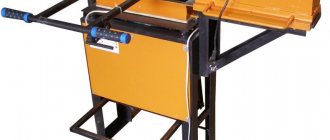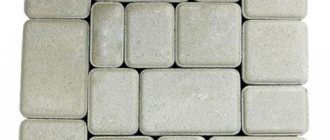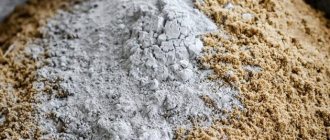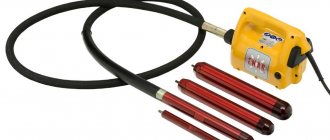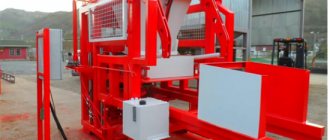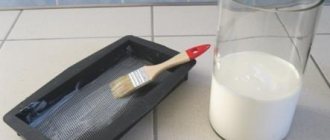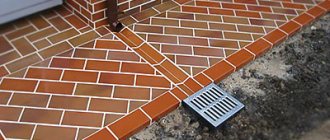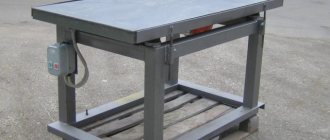Paving slabs are in excellent demand as a beautiful, durable and relatively inexpensive material for arranging paths and sidewalks.
It is equally successfully used both on the scale of one site and on a city scale.
With the right approach to business, the production of paving slabs can become a very profitable type of business.
Such production will not require large investments, and the use of special equipment will help ensure the production of tiles of the highest quality, in no way inferior in performance to the products of large industrial enterprises.
How are paving slabs made?
The technology for making paving slabs is quite simple: a sand-cement mixture is poured into molds and hardens. But tiles made in this way will turn out loose and very fragile.
To obtain the desired product, a vibropress is used, in which concrete is poured into a vibrating matrix, and a press presses on top of the cement mortar. The industry produces similar machines.
They are designed for the production of tiles on an industrial scale. Factory vibrating presses are very expensive; if you are not going to use the machine for commercial purposes, then purchasing it does not make sense.
You can make this mechanism yourself.
Vibration pressing
To eliminate the above disadvantages and increase productivity, vibration pressing technology has been developed:
- preparing concrete with the minimum possible water-cement ratio of 0.25 - 0.3 units in a concrete mixer;
- filling the mold matrix with the resulting concrete;
- pressing the mixture with a punch while turning on the vibration motor.
Unlike casting, vibration pressing allows you to immediately remove formwork, freeing up the mold for the production of subsequent units of product. The strength of the structural material increases, the structure of concrete improves, water permeability decreases, and frost resistance increases.
Due to the low water-cement ratio of the concrete mixture, there is a deficiency of cement laitance in it, even under the influence of a press. Therefore, the front surface of the FEM turns out to be rough, and not smooth, as with vibration casting. The adhesion of passers-by's shoes to the pavement surface increases, eliminating the need for anti-slip notches and corrugated tiles.
The concrete mixer and the press for paving slabs in this case are part of one automatic technological line, operating without human intervention according to the following principle:
- after delivery of raw materials (cement, sand, crushed stone, pigment), these materials are loaded into distribution bins;
- dispensers measure their quantity, bulk materials are fed into the concrete mixer;
- there they are mixed with each other and with water to form a working mixture;
- Concrete is fed into the hopper of the vibrating press using an inclined and reversible conveyor;
- the dispenser measures the amount of mixture to fill the mold matrix;
- finished products are formed using a punch and a vibrator;
- The tiles enter the steaming chamber or directly to the finished product warehouse.
By changing the settings of the dispensers, the composition of the mixture, the shape of the matrix and punch, on the same production line it is possible to produce vibratory-pressed bricks, paving/curb stones, facade tiles, wall/partition blocks.
In the “mini” configuration, the vibration press does not have a hopper and a processing line. The mortar mixture is prepared in a concrete mixer and poured into the matrix manually.
In its maximum configuration, equipment for the production of pressed tiles is a mini-factory. Productivity increases by a maximum of one and a half times, but the equipment allows you to completely get rid of manual labor and eliminate the human factor by 100%.
In this technology, the matrix with concrete solution stands motionless on the table. The brick press presses with a punch from above. Therefore, the front part of the paving element becomes more compacted, and its back surface becomes less durable.
Components for brick making press
To create a brick making machine, you need to imagine how it works (you can see the operation of a factory machine), the principle is the same.
Main components of the machine:
- Plate;
- Tabletop;
- Press;
- Vibromechanism.
Before starting production, it is important to make drawings of the parts. You can find several options for the machine on the Internet. You should choose based on the availability of components.
There are options for simpler brick presses, and there are more complex and powerful ones. To calculate the size of the machine, you need to decide on the size of the tile and the number of matrices. There is no point in creating a device for one form.
Tile production technologies
Before you finally decide on the choice of a machine for producing tiles, you should clearly understand what technologies for its production currently exist. There are two of them:
- Vibration pressing. A concrete solution with a low moisture content with constant vibration is placed between a punch (an element that exerts pressure on the working mixture) and a matrix, which determines the shape of the future product.
- Vibrocasting. Here, a more liquid concrete mixture is used, which is poured into special forms and subjected to vibration until they are filled evenly.
Depending on the methodology, the design of machines for the production of paving slabs may differ slightly.
Making a table
The machine table is a metal frame with welded legs. Dimensions are selected in accordance with the expected power of the structure.
Approximate dimensions:
- 50 by 70 centimeters or 70 by 100 centimeters.
- The height of the legs of the mechanism must correspond to the height of the person who will work on it.
- To make the legs, you can use a steel angle 10 centimeters wide, a ten-centimeter pipe or a tenth channel.
- The load on the legs will be large, so they need to be reinforced with gussets (steel rectangles welded to the leg and frame).
If the machine does not change its location, it is recommended to fill the legs with concrete.
Vibropressing machine
The simplest machine for the production of paving slabs using the vibration pressing method is a durable metal frame on which a loading device, a table for the unloading plate, a punch, a matrix and a small electric motor that is responsible for vibration are attached.
Professional machine for making paving slabs
The most popular industrial models are Tandem, Tandem-2, RPB 1500. These machines are compact, do not have complex mechanisms, and can be serviced by semi-skilled workers.
As a rule, the machine comes complete with several types of dies, which makes it possible to produce a wide range of paving slabs.
Frame making
Prepared blanks for the frame are welded using electric welding. Weld seams are cleaned using an angle grinder, then the entire workpiece is painted. It is advisable to paint in order to prevent rust: the cement-sand mixture is diluted with water.
The frame must have no in-plane displacements.
Making a countertop
This element of the press must be made with great strength because it will experience heavy loads.
- The dimensions of the table must match the tabletop.
- The frame is made from channel No. 10 or a corner 7cm by 7cm.
- The blanks are cut, trimmed and welded.
- When welding parts, it is necessary to ensure their evenness - during the welding process, metal structures can bend.
Then a rectangle is cut out of a 10 mm thick steel sheet, then placed on the prepared frame and welded. The top of the tabletop is a sheet.
Attaching the table top to the table
One way to secure a tabletop is to install it on springs. It is enough to install six springs about 12 cm long and 6 cm in diameter, which have great rigidity.
For springs, cups are cut out of the pipe. The diameters of the pipe and spring must match. The spring should sit tightly in the glass by one third of its length. The glasses are welded to the table and to the countertop, precisely marking their location points.
Electric motor for brick making machine
For the operation of a homemade concrete block press, an electric motor is required. The engine should be selected more powerful. It is recommended to use VI99/E. You can use any electric motor by connecting it with a belt to an eccentric.
Depending on the type, the engine is mounted below on a table top or on a work table. The electric motor is secured with bolts. To prevent the nuts from loosening due to vibration, engraving washers are used.
Vibrocasting
The cheapest equipment for paving slabs using the vibration casting method. The technology consists of a sequence of operations:
- production of architectural concrete from stone chips, sand, cement, water and plasticizer in a concrete mixer;
- filling plastic forms laid out on a vibrating table with architectural concrete;
- removing air bubbles from concrete by turning on the vibrating table for 5 - 10 seconds, depending on the thickness of the product;
- trimming excess mixture from a plastic mold;
- Grouting the back surface of the FEM with a float, float, or trowel;
- stacking forms with spacers between rows of sheet plastic;
- covering pallets with forms with plastic film;
- stripping after 48 hours by heating the forms in a hot water bath for 2 minutes;
- packaging of finished products on flights/pallets facing each other.
As you can see, 70% of the technology consists of manual labor. At the first stage, universal construction equipment is used - a concrete mixer.
Selection by characteristics:
- weight, dimensions;
- engine power;
- drum volume (total and effective);
- drum rotation speed;
- design (crown, gear).
The drum rotation speed is limited to 15 – 25 rpm. This is the maximum frequency that does not lead to the emergence of large centrifugal forces that hold the mixture on the walls of the drum. Large industrial models are powered from a 380 V network. Household models are connected to a 220 V network.
In addition to the concrete mixer, a vibrating table is required, on which the mixture is formed and compacted. Main parameters:
- tabletop dimensions;
- weight, dimensions;
- power consumed and active;
- coercive force;
- rotation frequency and vibration;
- mains voltage.
Both a concrete mixer and a vibrating table, if necessary, can be made at home from a 200 liter barrel and sheet and long rolled metal.
Equipment for other FEM production technologies is manufactured exclusively industrially.
For unmolding, a vibrating table (see video below) or special heating baths are used.
The main disadvantage of vibration casting is low productivity. Concrete takes two days to gain strength. During this time, the forms are occupied and cannot be moved, requiring a lot of additional space to temporarily store them.
Press manufacturing
The quality of paving slabs depends not only on vibration, but also on the amount of compression. You won’t be able to construct a hydraulic press with your own hands (you can use a jack).
It is easier to use human physical strength to compress the solution. The part (punch) is not difficult to make.
It is enough to weld the bracket with the axle to the table (short side). A lever is made from the profile, with a bushing at one end and a handle at the other. The lever should not be too long. It is attached to the punch. On the handle there is a remote control for turning on/off the electric motor.
The principle of operation of a vibrating table for tiles
The easiest way is to cast tiles into ready-made molds. However, the resulting material is loose and inferior in strength even to ordinary concrete. In addition, due to its compact size, it is difficult to achieve uniform shrinkage of the mixture.
As a result, strong bonds are not formed between the constituent components, and air voids remain in the body of the tile. In addition to the banal loss of strength, water penetrates into cracks and cavities. At sub-zero temperatures, the resulting ice will break the stacked blocks.
To obtain denser and higher-quality artificial stone, equipment for the production of paving slabs is equipped with a vibrator. Industrial designs work precisely on this principle.
A tile vibration press produces durable stone with a smooth front surface that does not allow moisture to pass through.
The mixture is loaded into the mold, then it is compacted by pressure and vibration, after which the stone dries under certain conditions. The more powerful the pressure is applied to the material, the better the quality of the final product.
Moreover, the best density is obtained when using vibration compaction, that is, simultaneous exposure to pressure and vibration.
Such a machine costs a lot of money; for the production of blocks at home it is an unaffordable luxury (unless, of course, you are engaged in commerce). Therefore, for one-time work, it makes sense to make a brick press with your own hands.
There are two concepts, each with advantages and disadvantages. Moreover, any machine can be manufactured at minimal cost.
note
A homemade brick press with a matrix for one tile is an inconvenient and unprofitable device. Even if you are creating a machine solely for personal use (not to mention commercial use), adding 2-3 cells will not complicate the project much, and the production speed will increase many times over.
How does a brick press work?
Before you start working on a homemade concrete block press, you need to properly prepare the cement-sand mixture.
The mixture consists of:
- Cement grade M 500;
- Crushed stone (fraction 5-10);
- Sand (fraction 2.5);
- Additives and dyes;
- Water.
To make high quality tiles, the mixture must be stiff. The tiles should have reduced moisture absorption and increased frost resistance.
You can check the prepared mixture using a truncated cone by lowering it into the solution. The mixture is considered to be of high quality if the steel cone enters the mixture 50 mm.
- Before filling with cement-sand mixture, the matrices must be lubricated with oil.
- This is done so that the cement does not adhere to the walls of the matrix.
- Then the cement mixture is distributed into molds.
- The matrix must coincide with the punch. By pressing the lever, the electric motor is briefly turned on.
- After this, the workpiece is removed from the matrix and laid out to dry.
With a strong desire, a minimum set of tools and materials, making a brick making machine yourself is a completely doable task.
Technology for the production of paving slabs by vibrocompression
To obtain a high-quality product, use a semi-dry working solution. To guarantee compliance with the recipe in production, full automation of the process is used, which includes the installation of a production line. In everyday life, it is necessary to use several recommendations that allow you to achieve a tile that is, although not completely ideal, but close to this indicator.
Preparation of concrete
Figure 2. Finished tiles
To produce a solution suitable for pouring into the matrix of a brick-making press that makes paving slabs, additional equipment is needed - a concrete mixer. The ready-made mixture is fed into the matrix placed on the table. After lowering the punch, it is compressed in the mold, then the concrete is subject to vibration created simultaneously by the table and the punch.
The composition of the mixture includes the following ingredients:
- Binding component: cement. It is better to use M500 so that the material is more durable and sets faster.
- Fillers: crushed stone (fraction 5–10) and coarse sand (fraction no less than 2.5).
- Additives: plasticizers, as well as solution dye.
- Water.
Requirements for the concrete composition for the production of paving stones by vibrocompression
When using a brick making press for the production of paving slabs, it is necessary to take into account increased requirements regarding the concrete composition. The technology assumes the presence of only hard mixtures. A low water-cement ratio is used in the production of products characterized by increased frost resistance, as well as low moisture absorption properties. Also, such materials ensure the preservation of the correct shape and guarantee the accuracy of the geometric parameters.
The rigidity of the concrete used is determined by monitoring the settlement of its cone. This is the most effective and simple method that allows you to get a sufficient idea of how flexible the concrete mixture is. This test is carried out using a truncated metal cone.
The container is filled with the solution in three steps, sealing it with a metal rod. Then the equipment is turned over, fixed on a verified flat plane and the cone is removed. When the shrinkage of the solution stops, measure the difference between its initial and final heights. If it does not exceed 50 mm, the mixture is inactive.
It is this kind of solution that is suitable for the manufacture of high-quality paving slabs, since the process of molding them from low-moving mixtures requires exposure to vibration and direct pressure in order to ensure that all voids are eliminated. Their absence ensures solidity, and therefore the strength of the finished product. The slightest violation of the water ratio can significantly reduce the final strength of the tile.
Molding
Figure 3. Formation of concrete
The procedure for forming paving slabs is as follows:
- first, a wooden pallet with a special metal matrix placed on it is placed on the frame of the brick making machine, which specifies the appearance and dimensions of the future product;
- then the finished concrete mixture is poured into the matrix;
- so that it completely fills the form, vibration is started for a short time;
- the product takes shape and the required parameters when exposed to vibration, as well as the pressure of the punch lowered into the matrix to create the required pressure;
- After the molding of the product is completed, the matrix rises simultaneously with the punch, leaving the finished product on a wooden pallet, which is moved along with it to a suitable place for drying.
Drying
The activity associated with drying and final hardening of the tiles takes place in a natural environment or inside a steaming chamber, where a given level of humidity and temperature is maintained.
Air drying is a long process requiring at least two days. The period of the process depends only on atmospheric humidity and ambient temperature. Inside the steaming chamber, the process lasts faster - 4–8 hours.
